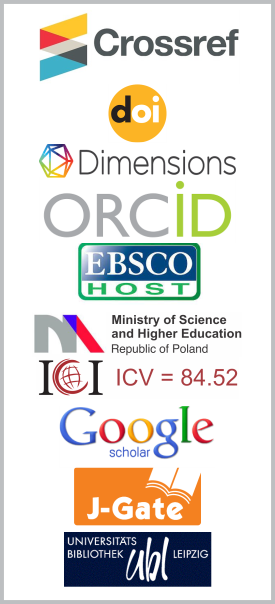Body Shape Variation in the Goby, Glossogobius giuris Collected in Selected Areas in the River of Norzagaray Bulacan Using Landmark-Based Geometric Morphometrics
DOI:
https://doi.org/10.26713/jims.v9i4.1021Keywords:
Geometric morphometrics, MANOVA, CVA, Relative warpsAbstract
The study was conducted to analyze body shape variations between sexes of G. giurisin different collection sites in Norzagaray River, Bulacan, Philippines using the tools of geometric morphometrics (GM), a combination of advanced different statistical tests to describe variations in shapes. The comparative study of G. giurispopulation structure using landmark-based morphometrics can be the reliable tool to describe variations in population structures of the fish from different areas of the river. The fish were collected and scanned for image capturing. After image capture, the fishes collected were preserved, dissected following the protocol of identification, authentication and gender determination by the Bureau of Fisheries and Aquatic Resources (BFAR) - Region III, Maimpis City, Pampanga, Philippines. The images of collected individuals of G. giuris were subjected to landmarking to obtain the x and y coordinates of the landmarks using the TpsRelw software. The raw coordinates were subjected to procrustes-fitting to superimpose the different orientation and position of the specimens. Relative warps Score generated by the TpsRelw were subjected to different statistical tests such as MANOVA, Discriminant Function Analysis and Canonical Variate Analysis. Results showed no differences in body shapes between sexes of G. giuris although variation within sexes were found to be the major contributor for the differences observed populations. This study has shown that GM is a useful tool to be able to quantitatively describe variations in populations.
Downloads
References
R. Froese and D. Pauly, FishBase, World Wide Web electronic publication, www.fishbase.org, version (01/2010).
J. Mahilum, C. Camama, J. Lalisan and S. Vedra, Morphology of Goby Species, Glossogobiuscelebius (Valenciennes 1837) and Glossogobius giuris (Hamilton 1822) in Lake Lanao Mindanao, Philippines, International Journal of Research in BioSciences 3(6), 2319 – 2844 (2013).
F.L. Bookstein, Morphometric Tools for Landmark Data: Geometry and Biology, p. 435, Cambridge University Press, New York (1991).
D.C. Adams, F.J. Rohlf and D.E. Slice, Geometric morphometrics: Ten years of progress following the "revolution”, The Italian Journal of Zoology 71(9), 5 – 16 (2004).
K. Unito-Ceniza, M.A.J. Torres and C. Demayo, Describing Body Shape of Goby, Glossogobius giuris (Hamilton, 1822), From Lake Mainit, Surigao Del Norte Using Landmark-Based Geometric Morphometrics, International Research Journal of Biological Sciences 3(6), 2278 – 3202, 6-17 (2013).
L.M. Ilustre, P. Roa, H.A. Quiaoit and M.C. Ablan, Morphometric Comparison of Dascyllustrimaculatus Populations from Bohol Sea, Philippines De La Salle University, Manila, Philippines (2014).
F.J. Rohlf,tps Dig, digitalize landmarks and outlines, version 2. 16. Department of Ecology and Evolution, State University of New York at Stony Brook (2010).
O. Hammer, D. Harper and P. Ryan, PAST: Paleontological Statistics Software for education and data analysis, PaleontologíaElectrónica 4(1) (2001).
A. Elewa, Morphometric studies on three ostracod species of the Genus Digmocythere Maldelstam from the middle Eocene of Egypt, Paleontologia Electronica 6(2), 1-1.1 (2003).
J.M. Lacson and D.C. Morizot, Temporal genetic variation in subpopulations of bicolor damselfish (Stegastespartitus) inhabiting coral reefs in the Florida Keys, Mar Biol. 110, 353 – 357 (1991).
J.A. Huey, A.M. Baker and J.M. Hughes, The effect of landscape processes upon gene flow and genetic diversity in an Australian freshwater fish, Neosilurushyrtlii, Freshwater Biol. 53, 1393 – 1408 (2008).
M.J. Jowers, B.L. Cohen and J.R. Downie, The cyprinodont fish Rivulus (Aplocheiloidei: Rivulidae) in Trinidad and Tobago: molecular evidence for marine dispersal, genetic isolation and local differentiation, J. ZoolSystEvol Res. 46, 48 – 55 (2008).
J.D. Hernandez-Martich and M.H. Smith, Downstream gene flow and genetic structure of Gambusiaholbrooki (eastern mosquitofish) populations, Heredity 79, 295 – 301 (1997).
N.J. Barson, J. Cable and C. van Oosterhout, Population genetic analysis of microsatellite variation of guppies (Poeciliareticulata) in Trinidad and Tobago: evidence for a dynamic source–sink metapopulation structure, founder events and population bottlenecks, J. Evol. Biol. 22, 485 – 497 (2009).
Downloads
Published
How to Cite
Issue
Section
License
Authors who publish with this journal agree to the following terms:- Authors retain copyright and grant the journal right of first publication with the work simultaneously licensed under a CCAL that allows others to share the work with an acknowledgement of the work's authorship and initial publication in this journal.
- Authors are able to enter into separate, additional contractual arrangements for the non-exclusive distribution of the journal's published version of the work (e.g., post it to an institutional repository or publish it in a book), with an acknowledgement of its initial publication in this journal.
- Authors are permitted and encouraged to post their work online (e.g., in institutional repositories or on their website) prior to and during the submission process, as it can lead to productive exchanges, as well as earlier and greater citation of published work.




